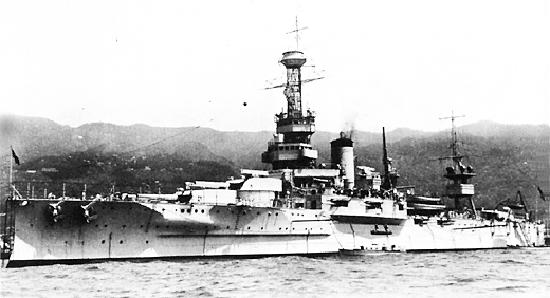
The United States Superdreadnaught Wyoming
The third USS Wyoming was commissiononed on September
25 September 1912 and becme the flagship of the commander of the United States Atlantic Fleet. The ship was a compromise.
The Royal Navy was already constructing ships with larger guns, but with larger guns, until port facilities on
the Atlantic and Pacific coasts could be updated, the United States would be
limited in the ports that it could use. Additionally, although the Royal Navy was converting to
oil, the Wyoming utilized coal.
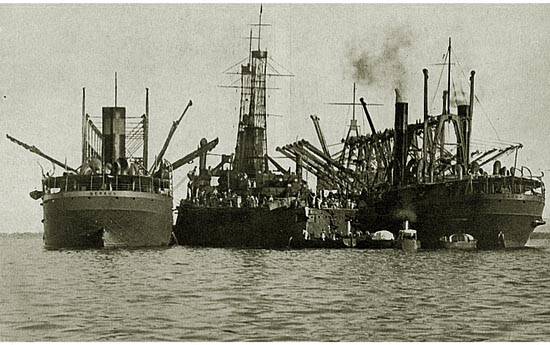
Recoaling the Wyoming.
The Wyoming had a length of
562 feet, beam of 93 ft. draft of 28 ft. 6 in. and with its 28,000 hp. turbin engines could
make a top speed of 21 knots. She saw duty during both world wars. Following entry of the
United States into World War I, she became a part
of the Sixth Battle Squadron of the "Grand Fleet." In 1918, the Wyoming and the
New York were inspected by King George V. On the Fourth of July, the King threw out the first
ball for a navy baseball game.
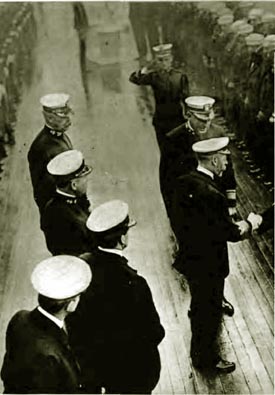 . .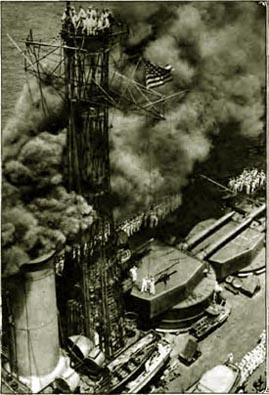
Left, His Majesty shaking hand with sailor on inspection of the
New York and the Wyoming at Scapa Flow, 1918.
Second officer on left is Admiral Sir David Beatty.
Right, Wyoming, Full steam Ahead."
Following the war, the Wyoming was a part of the
guard of honor escorting President Wilson on his return from the Versailles Peace Treaty negotiations.
In the 1920's, the ship was converted to oil. Peace time led to the more routine aspects of the
Navy, among them, lifeboat drills and scraping.
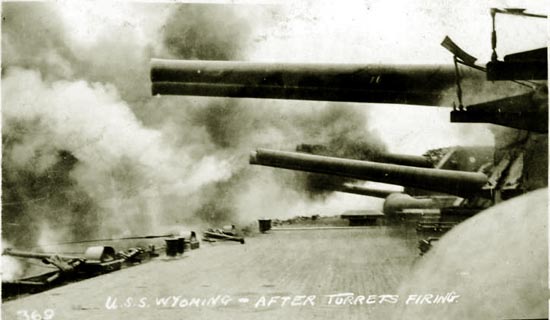
Gunnery exercise on the Wyoming.
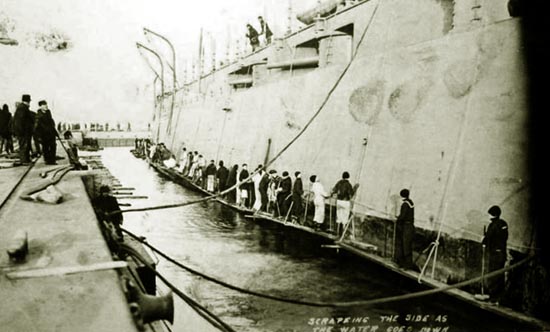
Scraping on the Wyoming.
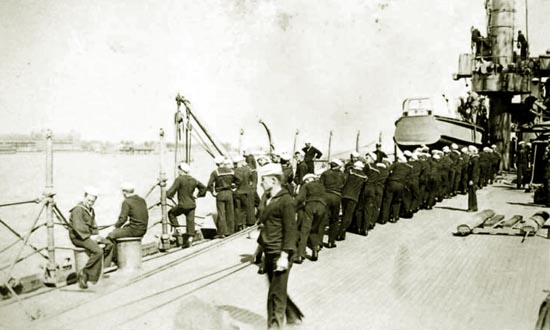
Life Boat Drill on the Wyoming.
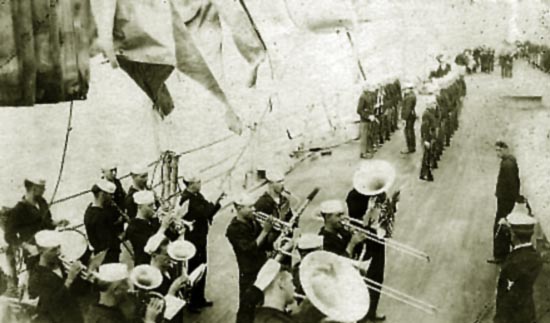
Ship's band, USS Wyoming, 1924.
By 1929, two airplanes were added to the ship for scouting purposes.The United States began experimental use of airplanes off of ships when
Eugene Burton Ely took off from a wooden platform constructed on the bow of the U.S.S. Birmingham.
Construction of the first purpose-built aircraft were approved by the Royal Navy in 1917. Pressure to complete the ship resulted in delays.
Thus, the Imperial Japanese Navy complete an aircraft carrier the Hosho in
1922. The United States Navy converted a collier into an aircraft carrier in 1920.
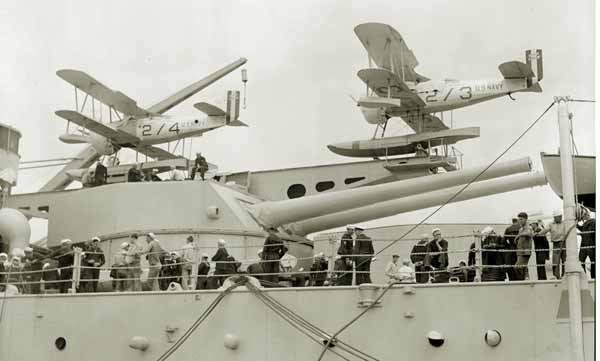
U.S.S. Wyoming showing airplanes, Boston Navy Yard, 1929.
In 1931, as a result of the London treaty limiting naval armaments, her armor was removed together
with the guns and turret machinery from three of its six main battery turrets and used as a gunnery training ship.
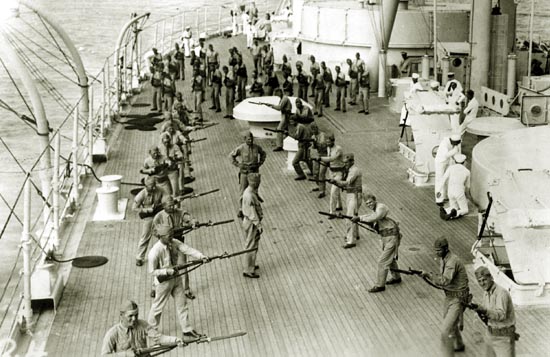
Marine bayonette drill, USS Wyoming, 1934.
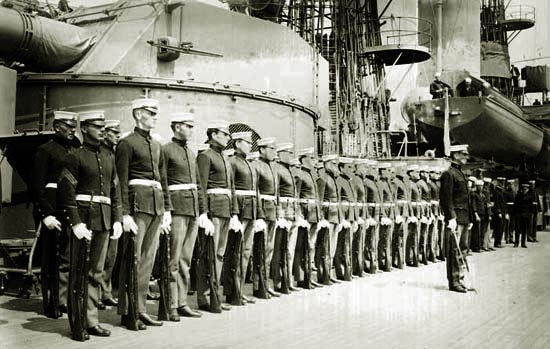
Marines, USS Wyoming.
With the advent of WW II, consideration was given to reinstalling the armour and turret. Instead, however, she remained
a gunnery training ship, training some 35,000 Sailors on seven different
types of guns. Among those
serving on her as Executive Officer was William Frederick Halsey, Jr., and
Lt. James Earle Carter, Jr., who served as Radar Officer.
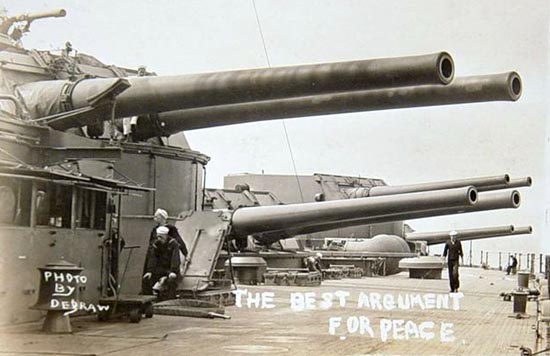
The Wyoming's Guns
Music this Page (courtesy Horse Creek Cowboy):
ANCHORS AWEIGH
Original Version:
("Stand Navy Down The Field",
writen for the 1906 Army-Navy Game)
Stand Navy down the field, sails set to the sky.
We'll never change our course, so Army you steer shy-y-y-y.
Roll up the score, Navy, Anchors Aweigh.
Sail Navy down the field and sink the Army, sink the Army Grey.
Get underway, Navy, decks cleared for the fray,
We'll hoist true Navy Blue o Army down your Grey-y-y-y.
Full speed ahead, Navy; Army heave to,
Furl Black and Grey and Gold and hoist the Navy, hoist the Navy
BlueOriginal Version
Blue of the Seven Seas; gold of God's great sun
Let these our colors be till all of time be done-n-n-ne,
By Severn shore we learn Navy's stern call:
Faith, courage, service true, with honor over, honor over all.
Current Version:
("Anchors Aweigh"
as re-writen in the 19020's)
Stand, Navy, out to sea, Fight our battle cry;
We'll never change our course, So vicious foe
steer shy-y-y-y.
Roll out the TNT, Anchors Aweigh.
Sail on to victory
And sink their bones to Davy Jones, hooray!/p>
Anchors Aweigh, my boys, Anchors Aweigh.
Farewell to college joys, we sail at break of day-ay-ay-ay.
Through our last night on shore, drink to the foam,
Until we meet once more,
Here's wishing you a happy voyage home.
|
Next page: The Hudson River Steamer Wyoming and the Schooner Wyoming.
|